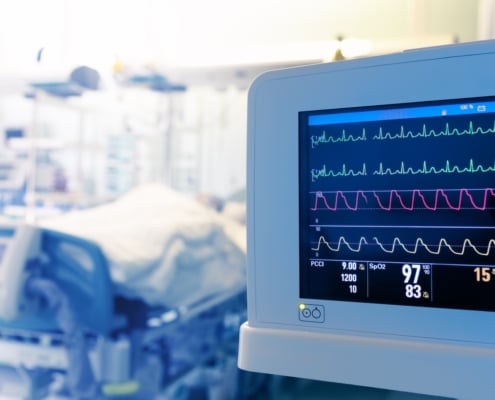What is a Tele ICU?

What Is Tele-Critical Care and How Does It Help Hospitals Serve Patients?
Diego Reino, MD, FACS | April 8, 2025
When the average patient, and even many providers, think of telemedicine, their minds immediately go to an image of a patient conferring with a general practitioner over Zoom, Teams or some similar application.
This image isn’t incorrect, but it also doesn’t tell the full story of just how much telehealth has evolved in the last few years.
A fair amount of today’s telehealth landscape is actually taking place fully within a clinical setting, with patients and providers interacting with one another via digital applications and even providers speaking directly with each other through electronic means. And this isn’t limited to generalists; in fact, some of the most creative offerings in the telehealth space are focused on translating the work of intensivists into successful digital products and services.
That includes work in the ICU. One of the questions I typically get when meeting with hospital CEOs, doctors and ICU managers is how exactly an application like Intercept Telehealth even works. There’s widespread unfamiliarity with the actual mechanics of a tele-intensive care unit, how to implement it, and the benefits to both staff and patients.
With that in mind, I wanted to provide some more details about what a tele-ICU is, the challenges tele-critical care can help solve, and how it works in practice.
Defining Tele-Critical Care
According to a study available at the National Library of Medicine:
“Intensive care unit telemedicine (tele-critical care), also commonly referred to as “virtual critical care,” “eICU” or “Tele-ICU,” is technology enabled care delivered from off-site locations that was developed to address the increasing complexity of patients and insufficient supply of intensivists.”
Now, this study was from 2018, and a couple developments have happened since then that have made virtual care in an ICU more attractive than ever. First, COVID-19 and the widespread availability of remote video technology in the aftermath of the global pandemic made the world far more comfortable with digital interfaces than they’d ever been before. Second, that technology became more precise, almost by necessity, with Microsoft, Zoom and other providers quickly investing and innovating in the space.
That means that the healthcare field is primed for adoption of tele-critical care technology and services in a way that might not have been possible in the pre-COVID era.
How Tele-Critical Care Helps Hospitals Confront 3 Key Challenges
And it couldn’t have come at a better time, as healthcare practitioners face a trifecta of challenges in their traditional ICUs:
- Aging population – The aging Baby Boomer population is hitting healthcare like a tidal wave, and this demographic shift is only going to grow more intense in the coming years. According to Census.gov, in just a few short years, ALL Baby Boomers will be over the age of 65. And seniors typically suffer at higher rates from the types of conditions that require admission to the ICU. That means higher patient loads, particularly in areas with high populations of retirees, such as Florida, where I practice.
- Shortage of Beds – The number of hospital beds has not been able to keep up with this demographic shift. In fact, in troubling news, a variety of hospital closures, particularly in rural areas, have led to a decline in available beds. This comes even as occupancy rates have risen far beyond what they were prior to the pandemic and as the number of seniors in the United States grows larger and larger.
- Staffing Shortage – Medical and nursing schools have simply not been able to pump out enough new doctors, nurses and support staff to keep up with this demographic shift. This is especially true for intensivists, who possess the unique skills and knowledge that is relied upon to guide care plans and stabilize the most at-risk patients.
Although it isn’t an immediate band-aid to these challenges, tele-critical care can act as a solution in a variety of ways. First and foremost, it can help alleviate staffing issues by supplementing the work of a care team, whether an ICU has an intensivist on staff or not.
If an intensivist is on site, it’s very likely that there aren’t enough of them to offer coverage at all hours of the day, nor to provide the requisite attention to the sheer number of patients who may be within the ICU at any given time. And if an intensivist isn’t on site, it becomes basically impossible to provide the level of diagnostic precision needed in the most critical, specialized patient cases.
A tele-critical care program can thus be relied upon to supplement the work of on-site staff members. The benefit is two-fold: it ensures patients are getting the critical intensive care they need to recover and be moved to a less intensive care setting, and it also helps on-site ICU teams feel less stress and burnout than they would if they were forced to deal with the nonstop influx of patients all on their own.
There’s one additional benefit we should mention: Cost. According to the Society of Critical Care Medicine:
“In selected settings, tele-ICU care has demonstrated shorter ICU LOS and lower ICU mortality, which may translate into lower hospital costs and better use of resources. A systematic review and meta-analysis of 19 ICU telemedicine studies concluded that tele-ICU programs were associated with reductions in ICU and hospital mortality and ICU LOS but not in hospital LOS and were costly to implement. An Emory Critical Care Center study showed that implementing an advanced practice provider (APP) residency program and tele-ICU staffed with critical care nurses and consultant intensivists resulted in a $4.6 million cost savings.”
How Does It Work?
You’ve seen the benefits of a tele-critical care program, but you may be wondering how, exactly, it works in practice.
At its simplest, a tele-ICU connects off-site intensivists (and other medical staff, such as nurses and Advanced Practice Providers) to patients within a given ICU. All the same patient diagnostics and data points that would be available on site are available to the off-site intensivist, the only difference being that that person or team isn’t right there in the room with the patient.
From this off-site location, the intensivist can monitor vital signs, direct the on-site team to the highest-need patients, identify potential threats to patients’ wellbeing and create care plans that will help improve patients’ conditions and graduate them out of the ICU and into a lower acuity setting.
In this way, a tele-intensivist can help a hospital dealing with staffing issues to properly keep tabs on high-risk patients. These patients can get life-saving care at the earliest possible moment rather than having to wait what could be hours for intervention. And the on-site team members get peace of mind (and far less stress) knowing that their patients are being properly looked after.
The Future of the ICU
The demographic shift is here, and its effect on ICUs is only going to become more pronounced.
Tele-critical care offers one possible solution to helping medical teams address the rapid increase in patients seeking ICU services. With off-site critical care teams delivering proactive and continuous care at all times and ready to react at once to patient needs, hospitals are better equipped to respond to an aging population, a lack of beds, and a lingering staffing shortage.
If you’re ready to get started, contact Intercept Telehealth. We’ll help you understand more about how a tele-critical care program could work within your unique practice, and also answer any questions you may have about tele-critical care. Reach out today.



